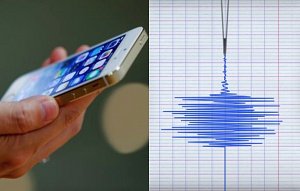Smartphones detect Earthquakes sending Early Warning to Users

Electronic devices such as smartphones could function as warning systems for large earthquakes. The new technology may benefit these regions of the World that struggle to afford good quality but expensive traditional earthquake early warning assets. The new devices may also give contribution to the higher technologic devices.
The new study was published on the 10th of April in the first volume of the new AAAS journal Science Advances. The scientists at the U.S. Geological Survey discovered that sensors in electronic devices such as smartphones could be used to build alternative earthquake warning systems.
Even though they present less accuracy than professional dedicated systems, the GPS (Global Positioning System) sensors present in smartphones can actually detect the ground movement and eventual displacement caused by large earthquakes’ effects.
The idea is to exploit the large number of electronic devices to make them interact among each other by providing individual feedbacks to be analysed collectively. Earthquake warnings would then be transmitted back to the users. Sarah Minson, USGS geophysicist and one of the lead authors of the research, explained: “Crowd-sourced alerting means that the community will benefit by data generated from the community,”
Earthquake early warning systems essentially detect the beginning of earthquakes and transmit warnings to people and warning systems before the starting of the shaking. The new technology would allow more countries to get early warning and would represent an important change according to the USGS geophysicist Benjamin Brooks who explained: “Most of the world does not receive earthquake warnings mainly due to the cost of building the necessary scientific monitoring networks”.
Researchers tested the efficacy of the new technology and, according to the results, Earthquakes Early Warnings may be activated with the contribution of just a small percentage of the population of a specific area. With the use of less than 5000 smartphones in a large metropolitan area, for instance, it could be possible to detect and analyse and earthquake fast enough to issue a warning alert to distant areas before the advent of strong shakings. Craig Glennie, a report author and professor at the University of Houston explained that “The speed of an electronic warning travels faster than the earthquake shaking does”. The idea is that the sensors in smartphones and similar devices could be exploited to deliver warnings for earthquakes of magnitude 7 or larger, but not for smaller ones.
Douglas Given, USGS coordinator of the ShakeAlert Earthquake Early Warning System, gave his opinion about the U.S. situation saying that: “The U.S. earthquake early warning system is being built on our high-quality scientific earthquake networks, but crowd-sourced approaches can augment our system and have real potential to make warnings possible in places that don’t have high-quality networks”. The United States Agency for International Development is collaborating with the Chilean Centro Sismologico Nacional, to fund a pilot project and test a pilot hybrid earthquake warning system including both smartphone sensors and professional scientific-grade sensors along the Chilean coast.
Bob Iannucci of Carnegie Mellon University, Silicon Valley said: “”The use of mobile phone fleets as a distributed sensor network – and the statistical insight that many imprecise instruments can contribute to the creation of more precise measurements – has broad applicability including great potential to benefit communities where there isn’t an existing network of scientific instruments”. Thomas Heaton, professor of Engineering Seismology at Caltech and co-author of the study said: “Thirty years ago it took months to assemble a crude picture of the deformations from an earthquake. This new technology promises to provide a near-instantaneous picture with much greater resolution”. Finally, Susan Owen of NASA’s Jet Propulsion Laboratory, Pasadena, gave her contribution to the study and said: “Crowd-sourced data are less precise, but for larger earthquakes that cause large shifts in the ground surface, they contain enough information to detect that an earthquake has occurred, information necessary for early warning”. Written by: Pietro Paolo Frigenti
